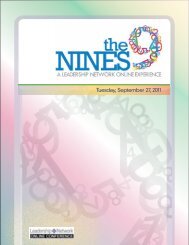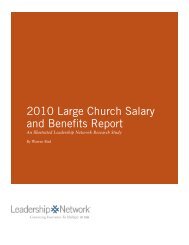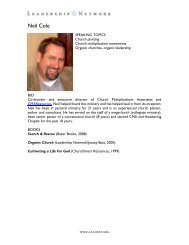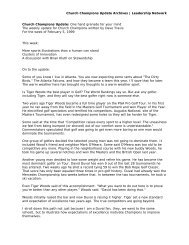ARE WE A PEOPLE AT HALF TIME? - Leadership Network
ARE WE A PEOPLE AT HALF TIME? - Leadership Network
ARE WE A PEOPLE AT HALF TIME? - Leadership Network
You also want an ePaper? Increase the reach of your titles
YUMPU automatically turns print PDFs into web optimized ePapers that Google loves.
What the new churches are is<br />
expressed well by the Fellowship of Las<br />
Colinas, in Irving, Texas, in its official<br />
statement of purpose: “We exist to reach<br />
up—which is worship (expressing love to<br />
God); to reach out—which is evangelism<br />
(or sharing Christ with others); and to<br />
reach in—which is discipleship (becoming<br />
fully devoted followers of Christ).”<br />
Although not usually fundamentalist in the<br />
sense so poorly received in liberal churchgoing<br />
and secular America, these churches<br />
are proudly evangelical—that is, they are<br />
devoted to missions and conversion—and<br />
take the Bible very seriously if not always<br />
literally. God’s word is the only thing<br />
about these churches that is considered<br />
sacred, and yet their people invoke Jesus as<br />
often and as familiarly as other people talk<br />
about their friends.<br />
A CHURCH OF OPTIONS<br />
Boomers as customers are<br />
accustomed to eclecticism,<br />
which is the embodiment of<br />
choice. In spontaneous imitation<br />
of that other late-century<br />
cathedral, the mall, the<br />
megachurch offers a panoply<br />
of choices under one roof—<br />
from worship styles to boutique<br />
ministries, plus plenty of<br />
parking, clean bathrooms, and<br />
the likelihood that you’ll find<br />
something you want and come<br />
back again. This is what the<br />
customer considers value.<br />
People may drive fortyfive<br />
minutes to an hour to get<br />
to a church like this—but then,<br />
as normal Americans, they’re<br />
in the habit. Bob Buford<br />
explains, “People don’t work<br />
in their neighborhoods. People<br />
don’t shop in their neighborhoods.<br />
People don’t go to the<br />
movies in their neighborhoods.<br />
So why should anyone expect them<br />
to go to church in their neighborhoods<br />
They’ll drive right by small churches in<br />
their neighborhood to get to attend a larger<br />
one that offers more in the way of services<br />
or programs.”<br />
The membership of most of the<br />
churches I visited was predominantly<br />
white, although in almost every one I could<br />
see a sprinkling of black and brown and<br />
Asian families. Most pastors plead that<br />
they attract the people who happen to live<br />
in their communities (defined as an<br />
agglomeration of ZIP codes). But they<br />
don’t look happy about it.<br />
Lyle Schaller, the church scholar, told<br />
me that race and ethnicity are “still a very<br />
significant line of demarcation” in most of<br />
American church life (except for very<br />
large, multicultural, charismatic congregations).<br />
The same impulse that drives people<br />
to worship with their own social kind,<br />
or to make the choice of a church a statement<br />
about the way they see themselves in<br />
the world, keeps them racially unmixed. In<br />
this sense the gated community lives.<br />
In Next Church circles<br />
there is a keen interest in<br />
creating churches, or services<br />
within churches, that<br />
minister to Americans in<br />
their twenties. I heard more<br />
than one exegesis of the<br />
differences in tastes and<br />
expectations, spiritual and<br />
otherwise, between Boomers<br />
and Busters.<br />
I did glimpse something<br />
of the Buster style in<br />
Chris Seay, the pastor of<br />
the University Baptist<br />
Church, in Waco, Texas,<br />
who is mellow as only a<br />
twenty-four-year-old can<br />
be. Seay ministers to a<br />
flock of twentysomethings<br />
and younger meeting in<br />
an old downtown movie<br />
theater.<br />
Seay, a third-generation<br />
pastor, says this about<br />
Busters: “It’s not that we<br />
don’t trust God; it’s that we<br />
don’t trust the institutions. They’ve let us<br />
down. But I don’t think Busters have<br />
rejected Christ.” His mission is to “communicate<br />
to seekers in a safe place,” he<br />
says. “They need a place where it’s safe to<br />
say, ‘I don’t believe this whole God thing.<br />
I think it’s a lot of malarkey.’”<br />
Like the mainline denominations,<br />
though perhaps with more success, new,<br />
large, independent churches attempt to live<br />
with intense divisions among their flock<br />
over abortion and homosexuality. Some,<br />
like Michael Foss, the pastor of Prince of<br />
Peace Lutheran Church, in suburban<br />
Minneapolis, are fiercely agnostic. “I’m<br />
convinced you can be a Christian on either<br />
side of those issues,” Foss told me when<br />
we talked last fall. “One of the tragedies of<br />
the culture is the tendency to draw lines<br />
where they needn’t be drawn. Christians<br />
ought to quit throwing rocks at Christians.<br />
We don’t have to agree on everything. And<br />
these are side issues. What we’re about is<br />
spiritual renewal.”<br />
Such dangerously free thinking is not<br />
always apparent among the Next Church<br />
pastors I spoke to. Like politicians, they<br />
put varying degrees of emphasis on teaching<br />
people the biblical injunctions on these<br />
matters, and in their hands Scripture stacks<br />
up pretty heavily against people who terminate<br />
viable pregnancies or enjoy nonprocreative<br />
sexual relations of any type.<br />
But it seemed to me also that their conclusion<br />
was always that compassion was necessary—vigilance<br />
against the sin, forgiveness<br />
for the sinner.<br />
I asked Ed Young, the pastor of Las<br />
Colinas, if his church could keep getting<br />
bigger and bigger, and he answered,<br />
“As long as we keep getting smaller and<br />
smaller.” The riddle is worth pondering.<br />
Growing churches and congregations,<br />
like growing businesses, have a reflexive<br />
thirst for market share. They tend to equate<br />
rising numbers with self-worth and bricks<br />
and mortar with godliness. But growth<br />
is also an expression of the evangelical<br />
mission.<br />
Not only self-styled evangelicals are<br />
growth-minded. Bill Tully, the rector of St.<br />
Bartholomew’s, a distinguished old mainline<br />
Episcopal church in New York City, is<br />
watching the large-church “restoration<br />
acts” across the country with an appreciation<br />
of the inherent tensions of growth.<br />
“People come to church to be touched,<br />
to belong,” he told me in an E-mail mes-<br />
4







